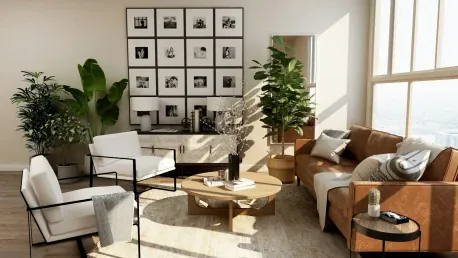Interior design is more than just decorating a space; it’s about transforming a house into a dynamic, personalized home that reflects your unique tastes and lifestyle. Liz Caan, a renowned interior designer from Newton, brings her expertise to the forefront, sharing her methods for creating authentic living spaces. In this article, we delve into Caan’s practical tips and insights that can help you personalize your home with confidence and creativity.
The Power of Color
Embrace Vibrant Shades
Many people shy away from using color due to the commitment it represents, but Liz Caan encourages experimentation. Her own home, filled with vibrant shades, demonstrates how color can positively influence mood and atmosphere. Using bold colors can transform a room from bland to exciting, playing a significant role in setting the tone and energy of the space. Colors such as rich reds, soothing blues, or lively greens can each invoke different feelings, helping to create the desired ambiance.
Color doesn’t only influence mood; it can also define and emphasize the architectural features within a home. By selecting vibrant shades that contrast or complement the distinct elements of a room, one can highlight unique details that might otherwise go unnoticed. Incorporating a variety of colors can create diverse zones within a space, offering both visual interest and functional differentiation. For those hesitant to dive headfirst into vivid hues, Caan suggests starting small, perhaps with accent pieces or smaller areas, before expanding to larger sections.
Mindful Color Application
Caan likens color to an ingredient in a recipe, suggesting that being mindful of how and where color is used can help achieve the desired effect. This thoughtful approach ensures that colors complement rather than overwhelm a space. Strategic color placement can also enhance the functionality and flow of different rooms. For example, using cheerful, bright hues in an entryway can create a welcoming atmosphere, while more subdued colors in a bedroom can promote relaxation and calm.
Caan highlights the importance of considering a room’s natural light when selecting colors, as this can affect how shades appear throughout the day. Additionally, she points out that different finishes—like matte, glossy, or textured—can also impact a color’s perception. Subtle variations in shade and finish can add layers of complexity and depth to a room without overwhelming the senses, making a space feel well-thought-out and expertly designed.
Patterns and Design
Creative Pattern Mixing
Combining different patterns can enhance visual appeal, yet mixing patterns often intimidates homeowners. Caan reassures readers by pairing organic patterns with structured ones to create dynamic but harmonious looks. She suggests incorporating patterns such as stripes, florals, checks, and abstracts in a balanced manner to achieve a cohesive and engaging aesthetic. By varying the scale and color palette of the patterns, one can ensure a harmonious integration that feels intentional rather than chaotic.
Caan offers practical advice on how to mix patterns effectively, such as starting with a dominant pattern and then layering in complementary designs. This method helps establish a focal point while adding depth and complexity to the overall look. She also emphasizes the importance of considering the function of the space when choosing patterns, ensuring that they enhance rather than distract from the room’s purpose. For instance, a bolder, high-contrast pattern might be more suitable for a lively living area, while softer, more subtle patterns can create a calming atmosphere in a bedroom.
Practical Pattern Tips
Drawing from her own experience, such as wallpapering her walls, dormers, and ceiling in the same print, Caan demonstrates how patterns can disguise architectural lines and minimize distractions, offering a cohesive design. This technique allows for a more streamlined appearance, reducing visual clutter and creating a sense of harmony. By extending the pattern across various surfaces, Caan shows how it is possible to unify different elements within a room, making the space appear larger and more interconnected.
Another effective approach is to use patterns to highlight specific areas or architectural features within a room. This can help draw attention to unique elements, such as alcoves or built-in shelving, adding visual interest while maintaining a sense of cohesiveness. Caan advises homeowners to experiment with patterns in unexpected places—for example, inside closets or on the backs of bookshelves. These small but impactful touches can infuse personality into a room and create delightful surprises for the observant eye.
Functionality in Design
Thoughtful Design Decisions
Functionality is key in interior design, as evidenced by Caan’s choice to remove kitchen wall cabinetry for a more open feel. This practical decision not only enhances the aesthetics but also improves the utility of the space. In her own kitchen, for example, removing the cabinetry allowed for additional storage options closer to the floor, creating a more efficient and accessible layout. This thought process underscores the importance of considering both form and function when making design choices.
Caan suggests that homeowners carefully evaluate their daily routines and how they use each space to identify potential improvements. Simple changes, such as rearranging furniture to facilitate movement or optimizing storage solutions to reduce clutter, can greatly enhance the functionality of a room. By prioritizing practical aspects without sacrificing style, it is possible to achieve a harmonious balance that meets both aesthetic and functional needs.
Balancing Utility with Aesthetics
Caan’s decisions, like not including seating at the kitchen island, illustrate how practical elements can be balanced with aesthetic considerations. This balance ensures that living spaces are both beautiful and functional. In her case, the nearby dining table provided sufficient seating, allowing the island to be used exclusively for meal preparation and storage. This thoughtful approach resulted in a more streamlined and efficient kitchen layout while maintaining visual appeal.
Similarly, incorporating multifunctional furniture and smart storage solutions can enhance the overall usability of a space. Pieces like ottomans with hidden storage or fold-out desks for compact areas can offer both style and practicality. Caan advises homeowners to invest in quality items that serve multiple purposes, as this can help maximize the potential of a room while ensuring that it remains visually pleasing. By being mindful of how every design decision impacts both form and function, one can create spaces that are as practical as they are beautiful.
Authentic Personalization
Reflecting Individual Authenticity
Personalizing a home involves creating spaces that genuinely represent the inhabitants. Caan’s design philosophy emphasizes decorating homes for the residents, not for others, ensuring authenticity. By focusing on individual preferences, it is possible to construct interiors that reflect unique personalities and lifestyles. This approach encourages homeowners to select pieces and design elements that truly resonate with them, rather than simply following trends or pleasing others.
Incorporating meaningful items, such as family heirlooms or travel souvenirs, can add a personal touch and create a sense of connection to the space. Caan suggests curating a mix of modern and vintage pieces to create a balanced and eclectic look that feels both timeless and contemporary. By blending different styles and periods, homeowners can establish a narrative that is both personal and visually intriguing, showcasing their distinct tastes and experiences.
Fearless Personal Expression
Interior design goes beyond merely decorating a space; it’s about transforming a house into a vibrant, personalized home that embodies your individual tastes and lifestyle. Liz Caan, a distinguished interior designer from Newton, brings her expertise to light, sharing her strategies for crafting genuine living environments. In this article, we explore Caan’s practical advice and insights that equip you with the skills to customize your home with confidence and creativity.
Caan emphasizes the importance of understanding your own preferences and lifestyles when designing your space. She suggests starting with a clear vision, incorporating personal mementos, and balancing aesthetics with functionality. It’s essential to add layers of texture and color to create a rich and engaging atmosphere. By following Caan’s approach, you can create a home that is not only stylish but also a true reflection of who you are, making your living space genuinely yours.









